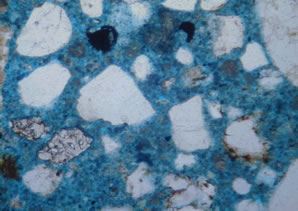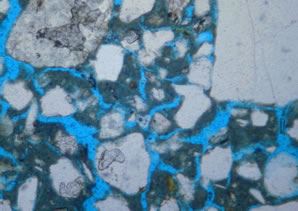For well over 30 years it has been common practice to prescribe the use of a Type-O masonry mortar for use on the conservation of masonry buildings. The most common formula of a Type-O mortar is 1:2:9, a blend of 1 part white Portland cement, 2 parts Type-S hydrated lime (most often dolomitic lime) and 9 parts sand by volume. In recent years there has been an increasing amount of research on similar mix designs and how they compare to Natural Hydraulic Lime (NHL) based mortars used in Europe to repoint historic masonry buildings. Just recently, a professor and two graduates of Columbia University published a research study on the same topic here in the United States. The results of this study can be found in the Association for Preservation Trades International bulletin Vol. XLIII. Their innovative approach to allow a real comparison between different mortar types used in conservation reveals some interesting results.
Petrographic thin section images courtesy of William Revie of The Construction Materials Consulting Group; Striling, Scotland
Petrographic thin section images courtesy of William Revie of The Construction Materials Consulting Group; Striling, Scotland

1 NHL : 3 Sand

1 Portland : 3 Sand

1 Putty : 3 Sand
The innovative approach the research team had developed with their curing protocol of various binder types, established a relatively level field of comparison for various mortars in regards to the way each mortar uniquely cures. With this testing detail established, the 11 commonly used repointing mortars were tested at various stages on their splitting tensile strength, compressive strength, water absorption and water-vapor transmission.
The tests reveal that for a splitting tensile strength the NHL/sand mortars are most comparable to traditional pure lime/sand mortars made of High calcium lime and dolomitic lime, while Type-O mortars were more than twice the splitting strength of NHL mortars. Although anecdotal, the cases where historic pure lime mortar has been used to repoint soft brickwork and has eroded causing a need for repointing, Type-O mortars could be consequently be too rigid for use a repointing mortar.
Compressive strength data shows that although NHL mortars have higher values than that of high-calcium lime mortars (with the exception of NHL 2 being less in strength than dolomitic lime) when compared to Type-O mortars their values are nearly half.
When mortars were measured for their water absorption, initially all NHL mortars significantly out-performed other mix designs. The most comparable mix was that of the Type-O mortars that ended up with similar characteristics to NHL mortars and still outperformed both pure lime mortars.
Water-vapor transmission results indicate that all NHL mortars process water vapor at much higher rates than dolomitic and both Type-O mortars, with values comparable to High-calcium lime mortars.
Although the results from the laboratory study are not entirely representative of values that are obtained in field work, they do represent what specifiers and conservation masons are attempting to achieve in real world situations. By eliminating variables, that can give anecdotal results and margins of error, the data suggests that NHL’s are indeed appropriate when specifying a historic repointing mortar or a new construction mortar used for masonry mortar, plaster or stucco applications.
In conjunction with this study and the new ASTM C1713 – Standard Specification for Mortars for the Repair of Historic Masonry, Natural Hydraulic Lime clearly proves its self as an alternative to mortar mix designs that have been used widely in the United States for many decades and have shown, for one reason or another premature failure.
Originally written by: Randy Ruth
Presented by: LimeWorks.us
Phone: 215-536-6706























